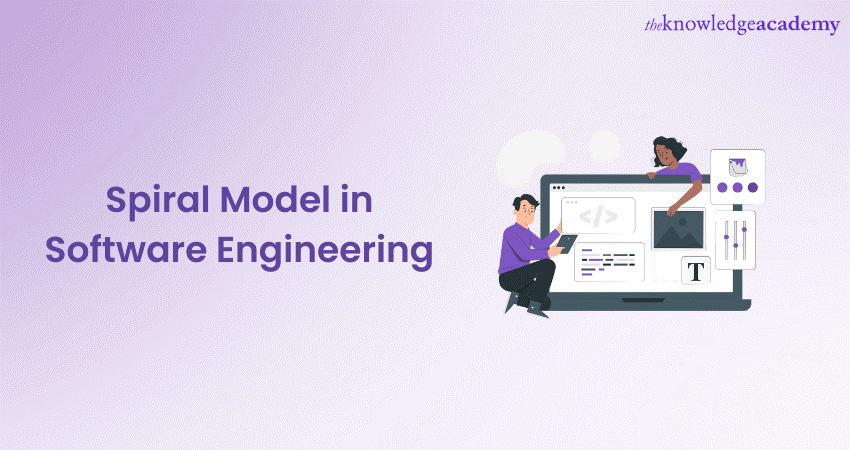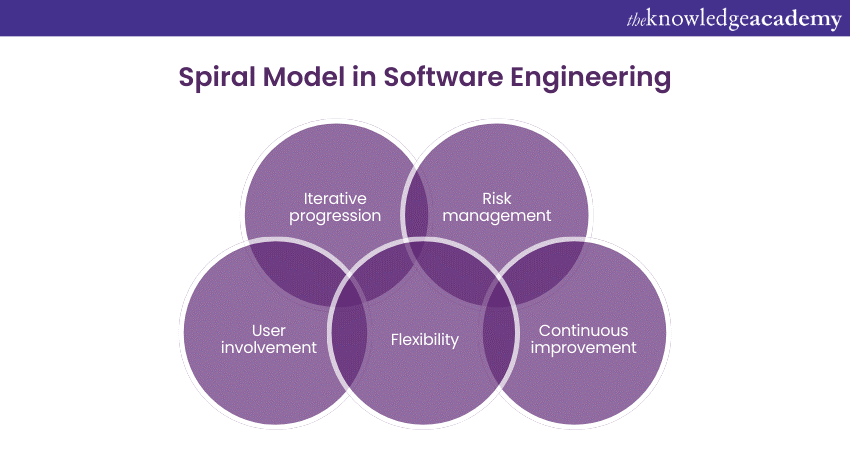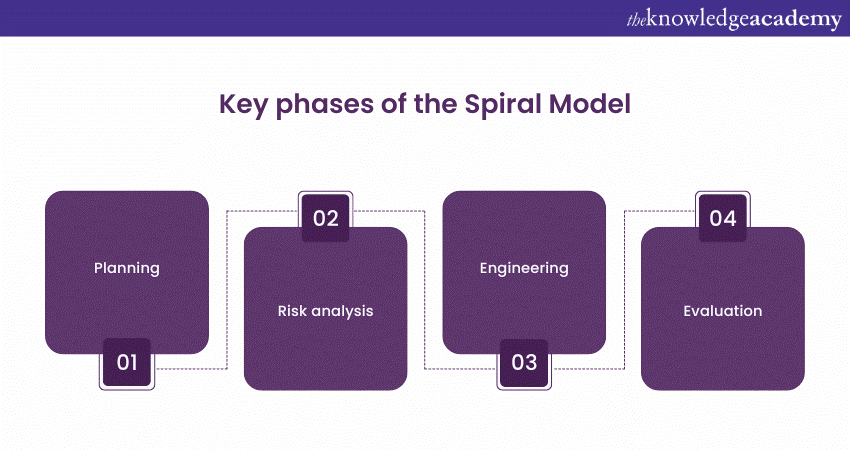We may not have the course you’re looking for. If you enquire or give us a call on +45 89870423 and speak to our training experts, we may still be able to help with your training requirements.
We ensure quality, budget-alignment, and timely delivery by our expert instructors.

When it comes to Software Development, efficiently managing complex projects is paramount. However, traditional linear models often struggle to adapt to evolving requirements and uncertainties, leading to delays, cost overruns, and subpar outcomes. Introducing the Spiral Model in Software Engineering, a dynamic approach that addresses these challenges.
Spiral Model emphasises iterative development, risk management, and continuous refinement throughout the development process. If you are interested in learning more about Spiral Model in Software Engineering, then this blog is for you. Let's delve in deeper!
Table of Contents
1) Introduction to the Spiral Model in Software Engineering
2) Key phases of the Spiral Model
3) Advantages of the Spiral Model in Software Engineering
4) Disadvantages of the Spiral Model
5) When to use the Spiral Model?
6) Conclusion
Introduction to the Spiral Model in Software Engineering
With their linear and sequential processes, traditional models like the Waterfall method struggled to cope with the challenges posed by uncertain requirements, technological advances, and shifting project landscapes.
Within this dynamic context, the Spiral Model has emerged as a revolutionary approach, combining iterative development, risk management, and continuous user engagement to tackle the intricate functions of Software Development.
As software projects grew in scale and complexity, it became evident that rigid methodologies could not adequately address the inherent uncertainties and complexities associated with such projects. Let’s explore the the core principles that guide the Spiral Model:

1) Iterative progression: The model's cycles reflect the iterative nature of development. Each iteration results in a refined product, with lessons learned from the previous process informing the next steps.
2) Risk management: Central to the model is identifying and mitigating risks. By addressing risks early in the process, the Spiral Model in Software Engineering aims to reduce the chances of costly setbacks and project failures.
3) User involvement: Recognising the importance of user feedback, the model integrates continuous user involvement and evaluation. This approach ensures the software aligns with user needs and expectations throughout development.
4) Flexibility: The model embraces change by allowing for adjustments in requirements, features, and project goals as the project progresses. This flexibility accommodates the dynamic nature of Software Development.
5) Continuous improvement: The lessons learned from each iteration drive continuous improvement. This iterative learning process enhances the development team's understanding of the project and its challenges.

Key phases of the Spiral Model
From planning to evaluation, there are four key phases in the Spiral Model. Understanding these key phases is essential for effective implementation and management. Besides, it provides a structured framework for Software Development teams to navigate these cycles effectively. Here are the phases of the Spiral Model:

a) Phase 1: Planning: In this initial phase, project objectives, requirements, and constraints are identified and analysed. The project scope is defined, and potential risks are assessed to develop a comprehensive plan for the subsequent phases.
b) Phase 2: Risk analysis: Risk analysis involves finding potential uncertainties and risks that may affect the project's success. Risks are gauged based on their likelihood and potential impact, and strategies are developed to mitigate or manage them effectively.
c) Phase 3: Engineering: The engineering phase focuses on developing, testing, and refining the software solution. Iterative cycles of development are carried out, with each cycle building upon the previous one to incorporate feedback and address emerging requirements.
d) Phase 4: Evaluation: The evaluation phase involves reviewing the progress made during the engineering phase and measuring the quality and functionality of the software solution. Feedback from stakeholders and end users is solicited and used to inform further iterations of the development process.
These key phases of the Spiral Model form a continuous and iterative cycle. They allow Software Development teams to adapt and evolve their approach based on changing requirements, feedback, and project dynamics.
Advantages of the Spiral Model in Software Engineering
The Spiral Model's core principle of integrating risk management processes into every phase addresses the uncertainties that often plague software projects. By identifying potential risks early and formulating mitigation strategies, development teams can proactively manage challenges before they escalate into significant roadblocks.
This risk-driven approach enhances the project's chances of success and reduces the likelihood of budget overruns or project failures.
The Spiral Model's iterative cycles accommodate these changes by allowing modifications at each phase. This adaptability ensures that the software remains aligned with the latest requirements and can be adjusted as necessary without derailing the entire project.
Software projects are ultimately aimed at delivering value to users. The Spiral Model's continuous involvement of stakeholders and users ensures that their perspectives are integrated throughout development.
This user-centric approach results in a product that meets user expectations, as their feedback is solicited and incorporated at each iteration; the model increases the likelihood of creating a successful and satisfying end by keeping users at the centre product.
The model's iterative nature involves regular feedback loops with stakeholders, including users, project managers, and developers. This ongoing feedback mechanism facilitates constant communication and collaboration. It allows identification of issues, the validation of project direction, and the correction of deviations from the project's goals. This continuous dialogue ensures that the project remains on track and that any emerging challenges are addressed promptly.
In the Spiral Model, each iteration produces a functional prototype or version of the software. This incremental development approach provides tangible progress at the end of each cycle. Stakeholders can see and interact with a working product, which helps visualise the project's direction and provides a clear sense of advancement. This incremental value delivery is precious for large projects that were waiting until the end.
Looking to master the art of Software Development and Design? Look no further than Software Design and Architecture Training.
Disadvantages of the Spiral Model
The cyclic and iterative nature of the Spiral Model can lead to increased complexity in Project Management. Managing multiple iterations, each with its Planning, Risk analysis, Engineering, and Evaluation phases, requires meticulous coordination and tracking.
Project Managers must maintain a comprehensive overview of the project's progress, risks, and adjustments across each cycle, which can be demanding and time-consuming.
The Spiral Model's continuous feedback loops and iterative development approach demand significant resources throughout the project's lifecycle. Developers, stakeholders, and users need to be consistently engaged, which can strain the availability of these resources. Additionally, the cost associated with adapting to changes and addressing risks at each phase can accumulate, potentially affecting project budgets and resource allocation.
Compared to more linear models like the Waterfall, the Spiral Model's timelines can be harder to predict. The iterative cycles, which accommodate changes and evolving requirements, might result in project timelines that need to be more defined. This uncertainty can make it challenging to set expectations, particularly for projects that must adhere to strict deadlines or contracts.
While involving users and stakeholders is a significant advantage of the Spiral Model, it can pose challenges. Consistently engaging users requires their availability and commitment throughout the project. Gathering and incorporating user feedback at each iteration can be time-consuming and may lead to scope creep as new features are continually suggested.
Moreover, differing opinions and conflicting requirements from various stakeholders can complicate decision-making.
When to use the Spiral Model?
Understanding the optimal scenarios for deploying the Spiral Model is crucial. It allows Software Development teams to make informed decisions about their methodologies. Let's explore the ideal scenarios for using the Spiral Model:
a) Complex projects: The Spiral Model in Software Engineering is particularly advantageous for projects with significant complexity. This includes size, scope, or technical challenges. Its iterative and risk-driven nature allows for a structured and adaptable approach.
b) Uncertain requirements: In environments where project requirements are subject to change or not fully defined initially, the Spiral Model's adaptability shines. Its iterative approach accommodates evolving requirements. This enables development teams to make adjustments and refinements based on emerging needs.
c) Dynamic environments: Projects influenced by rapidly changing market conditions, user feedback, or technological advancements benefit from the Spiral Model's iterative nature. Its ability to accommodate shifts ensures that the software remains aligned with evolving trends and expectations.
d) High-risk scenarios: The Spiral Model's risk-driven approach suits projects with significant risks. This includes technical, financial, or market-related risks. By integrating continuous risk analysis and mitigation strategies, potential challenges are addressed before escalation.
e) Mitigating challenges: Proactive risk management embedded within the Spiral Model ensures timely identification and resolution of potential issues. Continuous monitoring and mitigation enhance the project's success rate.
Conclusion
Spiral Model in Software Engineering stands as a dynamic and risk-conscious ally. Its iterative cycles, fortified by effective Risk management and user engagement, offer a strategic approach to complex projects. While it navigates challenges of uncertainty and evolving requirements, the model isn't exempt from complexities and resource demands. It serves as a powerful option for large-scale, evolving, and high-risk projects.
Unlock your Software Development potential with our Software Development Lifecycle Training.
Frequently Asked Questions
How does the Spiral Model differ from other Software Development methodologies?

Unlike Traditional Waterfall methodologies, the Spiral Model emphasises iterative development and risk management. It allows for early and continuous stakeholder feedback, enabling teams to adapt and refine the software solution throughout the development process. This approach fosters greater flexibility and responsiveness.
What tools and techniques are associated with the Spiral Model in Software Development?

The Spiral Model utilises various tools and techniques to facilitate iterative development and risk management. Commonly employed tools include Project Management software, prototyping tools, and risk assessment frameworks. Techniques such as prototyping, incremental development, and continuous risk analysis are also essential.
What are the other resources provided by The Knowledge Academy?

The Knowledge Academy takes global learning to new heights, offering over 3,000 online courses across 490+ locations in 190+ countries. This expansive reach ensures accessibility and convenience for learners worldwide.
Alongside our diverse Online Course Catalogue, encompassing 19 major categories, we go the extra mile by providing a plethora of free educational Online Resources like News updates, Blogs, videos, webinars, and interview questions. Tailoring learning experiences further, professionals can maximise value with customisable Course Bundles of TKA.
What is the Knowledge Pass, and how does it work?

The Knowledge Academy’s Knowledge Pass, a prepaid voucher, adds another layer of flexibility, allowing course bookings over a 12-month period. Join us on a journey where education knows no bounds.
What are related courses and blogs provided by The Knowledge Academy?

The Knowledge Academy offers various Software Engineering Courses, including Software Development Lifecycle Training, Software Design and Architecture Training and Agile Software Development Training. These courses cater to different skill levels, providing comprehensive insights into Software Engineering methodologies.
Our Programming & DevOps Blogs cover a range of topics related to Software Engineering, offering valuable resources, best practices, and industry insights. Whether you are a beginner or looking to advance your Software Engineering skills, The Knowledge Academy's diverse courses and informative blogs have you covered.






 Top Rated Course
Top Rated Course



 If you wish to make any changes to your course, please
If you wish to make any changes to your course, please


